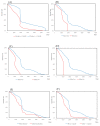Impact of the Serum Level of Albumin and Self-Assessed Chewing Ability on Mortality, QOL, and ADLs for Community-Dwelling Older Adults at the Age of 85: A 15 Year Follow up Study
- PMID: 33137946
- PMCID: PMC7692472
- DOI: 10.3390/nu12113315
Impact of the Serum Level of Albumin and Self-Assessed Chewing Ability on Mortality, QOL, and ADLs for Community-Dwelling Older Adults at the Age of 85: A 15 Year Follow up Study
Abstract
Quality of life (QOL) and mortality are true endpoints of epidemiological or medical research, especially for community-dwelling older adults. Nutritional status and activities of daily living (ADLs) are associated with QOL and mortality. Good oral health status supports a good nutritional status. The aim of this study was to elucidate the complex structure of these important health-related factors. We surveyed 354 healthy older adults at the age of 85. Nutritional status was evaluated by the serum level of albumin. QOL, ADLs, self-assessed chewing ability, serum albumin level, and mortality during the 15 year follow up period were analyzed. Self-assessed chewing ability was associated with QOL and ADLs. Self-assessed chewing ability for slight-hard foods was associated with mortality in men. However, it was not associated with the serum albumin level. The serum albumin level was associated with mortality in women. These results indicate that maintaining good oral function is not enough. Nutritional instruction in accordance with oral function is indispensable for health promotion in older adults. When planning health promotion strategies for older adults, different strategies are needed for men and women.
Keywords: ADL; QOL; Serum albumin; mortality; self-assessed chewing ability.
Conflict of interest statement
The authors state that they have no financial or nonfinancial conflicts of interest regarding this research.
Figures





Similar articles
-
Mortality-and Health-Related Factors in a Community-Dwelling of Oldest-Older Adults at the Age of 90: A 10-Year Follow-Up Study.Int J Environ Res Public Health. 2020 Dec 21;17(24):9584. doi: 10.3390/ijerph17249584. Int J Environ Res Public Health. 2020. PMID: 33371399 Free PMC article.
-
Effects of self-assessed chewing ability, tooth loss and serum albumin on mortality in 80-year-old individuals: a 20-year follow-up study.BMC Oral Health. 2020 Apr 21;20(1):122. doi: 10.1186/s12903-020-01113-7. BMC Oral Health. 2020. PMID: 32316955 Free PMC article.
-
Impact of periodontal disease and chewing ability on the quality of life of the elderly in an affluent community.J Formos Med Assoc. 2020 Nov;119(11):1693-1701. doi: 10.1016/j.jfma.2020.01.002. Epub 2020 Jan 23. J Formos Med Assoc. 2020. PMID: 31982268
-
Nutrition and oral health.Best Pract Res Clin Gastroenterol. 2001 Dec;15(6):885-96. doi: 10.1053/bega.2001.0247. Best Pract Res Clin Gastroenterol. 2001. PMID: 11866483 Review.
-
Prognostic Role of Serum Albumin, Total Lymphocyte Count, and Mini Nutritional Assessment on Outcomes After Geriatric Hip Fracture Surgery: A Meta-Analysis and Systematic Review.J Arthroplasty. 2019 Jun;34(6):1287-1296. doi: 10.1016/j.arth.2019.02.003. Epub 2019 Feb 11. J Arthroplasty. 2019. PMID: 30852065
Cited by
-
Association between serum albumin and severe impairment of activities of daily living in patients with stroke: a cross-sectional study.Front Neurol. 2025 Jan 6;15:1501294. doi: 10.3389/fneur.2024.1501294. eCollection 2024. Front Neurol. 2025. PMID: 39835151 Free PMC article.
-
Structure and Validity of Questionnaire for Oral Frail Screening.Healthcare (Basel). 2021 Jan 5;9(1):45. doi: 10.3390/healthcare9010045. Healthcare (Basel). 2021. PMID: 33466528 Free PMC article.
-
Spatial-temporal analysis of urban-rural differences in the development of elderly care institutions in China.Front Public Health. 2022 Dec 22;10:1086388. doi: 10.3389/fpubh.2022.1086388. eCollection 2022. Front Public Health. 2022. PMID: 36620273 Free PMC article.
-
Development and validation of a predictive model for prolonged length of stay in elderly type 2 diabetes mellitus patients combined with cerebral infarction.Front Neurol. 2024 Aug 1;15:1405096. doi: 10.3389/fneur.2024.1405096. eCollection 2024. Front Neurol. 2024. PMID: 39148703 Free PMC article.
-
Health-related quality of life in Thai patients with hepatocellular carcinoma and its influencing factors: A cross-sectional study.Belitung Nurs J. 2025 Aug 3;11(4):370-383. doi: 10.33546/bnj.3853. eCollection 2025. Belitung Nurs J. 2025. PMID: 40766262 Free PMC article.
References
-
- Leonardi M., Chatterji S., Koskinen S., Mateos A.J.L., Haro J.M., Frisoni G., Frattura L., Martinuzzi A., Adamczyk T.B., Gmurek M., et al. Determinants of health and disability in ageing population: The COURAGE in Europe Project. Clin. Psychol. Psychother. 2014;21:193–198. doi: 10.1002/cpp.1856. - DOI - PubMed
-
- Gómez H.A.I., Ayala A., García R.M.P., Blázquez R.T.C., Rodríguez R.T.V., Pérez V.F., Mayoralas F.G., Laso R.A., Larrañaga C.A., Forjaz M.J. The WHO active ageing pillars and its association with survival: Findings from a population-based study in Spain. Arch. Gerontol. Geriatr. 2020;90:104114. doi: 10.1016/j.archger.2020.104114. - DOI - PubMed
MeSH terms
Substances
Grants and funding
LinkOut - more resources
Full Text Sources

